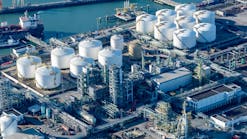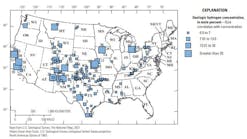Biden administration grants $7 billion in funding to seven US hydrogen hubs
US President Joe Biden and Energy Secretary Jennifer Granholm have announced the seven recipients of $7 billion in federal grants to accelerate development of regional hydrogen hubs under the bipartisan infrastructure law. Included among the recipients was HyVelocity, put forward by ExxonMobil Corp., Chevron Corp., Air Liquide SA, Mitsubishi Power Americas, AES Corp., Sempra Infrastructure, and Orsted AS.
Collectively, the hubs aim to produce more than 3 million tonnes/year (tpy) of clean hydrogen, or roughly one third of the 2030 US clean hydrogen production goal. They will also eliminate 25 million tpy of end-use carbon dioxide (CO2) emissions from end uses each year, according to the Biden administration.
HyVelocity will be developed on the US Gulf Coast of Texas and Louisiana, an area that already contains the world’s largest concentration of hydrogen production, customers, and energy infrastructure, including a network of 48 hydrogen plants connected by more than 1,000 miles of dedicated pipeline (OGJ Online, May 1, 2023).
Hubs selected in addition to HyVelocity, the amount awarded, and their regions include:
- Mid-Atlantic Clean Hydrogen Hub (MACH2), up to $750 million; Pennsylvania, Delaware, New Jersey.
- Appalachian Regional Clean Hydrogen Hub (ARCH2), up to $925 million; West Virginia, Ohio, Pennsylvania.
- Alliance for Renewable Clean Hydrogen Energy Systems (ARCHES), up to $1.2 billion; California.
- Heartland Hydrogen Hub, up to $925 million; Minnesota, North Dakota, South Dakota.
- Midwest Alliance for Clean Hydrogen (MachH2), up to $1 billion; Illinois, Indiana, Michigan.
- Pacific Northwest Hydrogen Hub (PNW H2), up to $1 billion; Washington, Oregon, Montana.
DOE’s Hydrogen Shot aims to reduce the cost of clean hydrogen by 80% to $1/kg in one decade and decrease carbon emissions to not more than 2 kg of carbon per 1 kg of hydrogen produced. As part of this effort, HyVelocity will collaborate with other hubs to develop an interconnected national framework for hydrogen production and end use (OGJ Online, Apr. 10, 2023).
In addition to the hubs, DOE will fund:
- $1 billion for a Clean Hydrogen Electrolysis Program: Electrolysis (using electricity to split water into hydrogen and oxygen) allows for clean hydrogen production from carbon pollution-free power sources like wind, solar, and nuclear.
- $500 million for Clean Hydrogen Manufacturing and Recycling: Supporting manufacturing of clean hydrogen equipment and improved efficiency and cost-effectiveness of domestic supply chains for key components, as well as the reuse and recycling of clean hydrogen technologies.
First-phase funding of these two initiatives—totaling $750 million and announced in March 2023—aimed to dramatically reduce the cost of electrolyzers and other clean-hydrogen technologies. The Biden administration reports that “even before project selections have been announced, these initiatives are already demonstrating payoffs by building investor confidence,” citing private sector commitments from the First Movers Coalition representing 1 million tpy of clean hydrogen demand and projects amounting to 12 million tpy of planned US clean hydrogen production.
The Bipartisan Infrastructure Law allocated $65 billion for clean energy investments at the Department of Energy (DOE), including $8 billion for the Regional Clean Hydrogen Hubs Program to support the development of hubs for clean hydrogen production, delivery, and end-use. Hydrogen can be produced from solar energy, wind, nuclear energy, biomass, and natural gas with carbon capture. The remaining $1 billion will be used for demand-side support to drive end-uses of clean hydrogen.
More information about hydrogen end-use applications can be found at OGJ’s sister publication, IndustryWeek.

Christopher E. Smith | Editor in Chief
Christopher brings 27 years of experience in a variety of oil and gas industry analysis and reporting roles to his work as Editor-in-Chief, specializing for the last 15 of them in midstream and transportation sectors.

